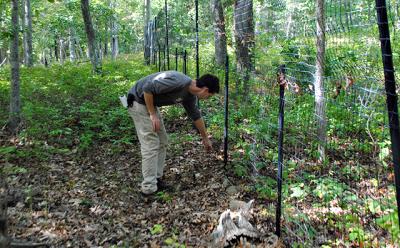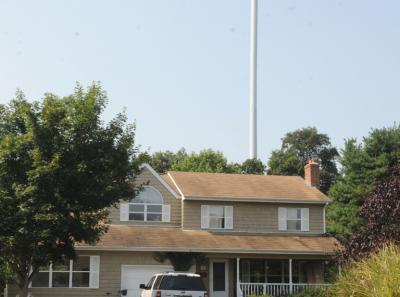Munching Deer Leave No Leaves In the Forest
Munching Deer Leave No Leaves In the Forest

When you go into the woods with Marguerite Wolffsohn, your vision starts to change. At first look, the view through tall pines and oaks and spindly sassafras trees into bright spaces where the sun reaches open ground, covered with grass, is a pleasing sight.
But then Ms. Wolffsohn describes her more knowledgeable view: The small plants under the trees are primarily huckleberry or ferns, plants that deer don’t much like. Look for the sapling trees and variety of young shrubs that should fill the mid-layer under the trees, and there is nothing much to see. There is leafy vegetation above a certain height and wide open space where a dense understory should be.
It is not that Ms. Wolffsohn, East Hampton Town’s planning director and a longtime nature observer here, wants to diminish anyone’s enjoyment of a forest stroll. Just the opposite. She cares passionately about the forest ecosystem, all of it, and wants to insure the health of all of the elements that keep it in balance, from the soil where seedlings take root, to the understory of native shrubs and small trees, to the established pines whose lower limbs are being stripped of leaves by munching deer.
All of it — the soil microbes and insects, the berries and nuts and seeds and leaves — supports the birds, reptiles, and mammals that together need, and feed, a healthy, balanced ecosystem.
The deer are herbivores that eat just about anything in the woods. A full-grown deer of 100 pounds, Ms. Wolffsohn said, eats five to nine pounds of vegetation a day. “That’s a lot of leaves, because they don’t weigh a lot,” said Andy Gaites of the town’s land management department, another guide on a recent afternoon forest tour.
Ms. Wolffsohn points to the difference, at deer-mouth height, between the abundance of plants at various levels of the woods. The damage is already obvious and widespread, she says. Ms. Wolffsohn, along with Mr. Gaites, supports what they see as the only viable option to reverse the damage: increased hunting.
A town deer management plan calls for that, among other things, and steps have already been taken to facilitate it, such as opening up more land to hunters.
Mr. Gaites walks down a trail to an area pinpointed on a global positioning system and marked by a wooden stake in the ground. A patch of woods there is one of eight study areas from Wainscott to Montauk that are being monitored to gauge the health of the forest. “We’re trying to show some of the damage in a scientific way,” he said. This is the second season the areas are being tracked, and comparisons will be made.
“You’re watching specific spots of seedlings to see if they can grow,” says Ms. Wolffsohn. “But aside from that, just take a look at the woods — a browse line is an indication that there’s just too many deer.”
If new trees, shrubs, and other plants are stripped of leaves or eaten entirely by deer as soon as they sprout, then the ongoing cycle of forest regeneration will halt, and areas like those observed on a recent forest tour will revert to open, meadow-type swaths.
“The acorns that drop from that tree,” Ms. Wolffsohn says, pointing at an oak, “there should be some of that.” But no oak saplings are growing below the tree. Mr. Gaites says there “should be at least 10 seedlings” coming up in the area around a healthy sassafras tree. “We had a hard time finding any.”
“When you see the grass in the woods returning, it’s not a healthy thing,” Ms. Wolffsohn says. “It’s not a meadow.”
Natural tangles of cat briar are important, as they provide nesting areas and food for forest songbirds. “Reduce the number and variety of sizes of plants like that, you’re going to reduce the number of species — birds, especially. It’s just wrong. It’s simplifying the habitat.”
If the impact of deer were reduced, the makeup of plants in the study plots would begin to change, and diversity return, Mr. Gaites believes. The deer have begun to browse on what he calls “stuffing food,” plants that are not preferred, but that are nonetheless beginning to show signs of being eaten: pines, beeches, red cedar. Those huckleberries — the only thing in lots of areas providing a green cover on the forest floor — could well be next.
Driving along Old Stone Highway in Springs, Ms. Wolffsohn turns her trained gaze out the window. “The leaves should be down to the ground,” she says, eyeing a stretch of woods. “The red maple, the tupelo, the sweet pepperbush should be thick under there.”
Deep into the Grace Estate, a 500-acre preserve in Northwest, there is a place Mr. Gaites and Ms. Wolffsohn have been watching, where a tall deer fence erected by residents adjacent to a preserve creates a stark line between one type of woods and another. Look through the fence onto the private land, and the lower levels of the forest are crowded, chock full of green. Goldenrod, low-bush blueberry, sumac, bittersweet, summer grape, and Virginia creeper are growing. Turn to the left, and the unprotected public land looks sparse by comparison. “It looks like somebody just cleared it yesterday,” Ms. Wolffsohn says.
In a 2014 report that is posted on the town website, Thomas J. Rawinski of the United States Forest Service, who took a similar tour of East Hampton’s woods, writes of observing “jaw-dropping deer impacts.” He called the sight “shocking, even to me.”
“We were witnessing deer-induced forest disintegration,” he said of the Grace Estate. “Unless the deer population can be brought into balance, the forest will continue to disintegrate.”
A number of other studies from forest ecologists across the country document the same issues. “It’s not just here, it’s the entire Northeast that has this problem, because we don’t have the predators” for deer, Ms. Wolffsohn says. “Like everything in ecology, it’s complicated.”
But, she says, “We’re hoping that the more people understand how bad the problem is, the more they’ll be willing to help with the solution.”
Not all are convinced. Bill Crain, the founder and head of the East Hampton Group for Wildlife, which is strictly opposed to an increase in hunting and advocates nonlethal deer management strategies instead, said this week that town officials should objectively evaluate what is occurring in the woods before setting deer policies.
At a forum sponsored by his group in June, he said, the town’s former natural resources director, Larry Penny, contended that deer have not significantly harmed the understory. There are other factors, Mr. Penny said, such as trees that inhibit growth beneath them.





